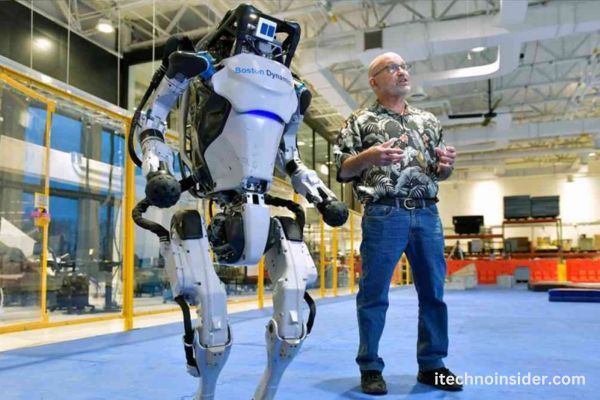
What Is Robot, Robotics?
Robotics involves the design, construction and use of machines to perform tasks that would otherwise be performed by humans. They have a number of benefits, including safety and productivity increases. Robots come in a variety of forms, from humanoid structures to wheeled platforms to robotic arms. But they all incorporate hardware for movement and sensors for data collection.
Humanoid-Robotics
Designed to resemble humans, humanoid Robotics are popular for customer service roles and healthcare applications. They can perform repetitive tasks faster and more accurately than their human counterparts, which increases productivity. They can also work in hazardous environments, keeping workers safe.
In manufacturing, humanoid robots can handle dangerous and repetitive tasks that require precision, reducing the risk of workplace injuries. They can also perform quality checks on parts to ensure they meet specifications, increasing efficiency.
Humanoid robots can help patients recover from physical therapy by following their treatment plans and ensuring they follow the correct exercises. They can also assist with household chores, allowing humans to focus on more important tasks. In addition, they can provide companionship and interaction for elderly family members or those who live alone, reducing feelings of loneliness.
Pre-programmed
Pre-programmed robots are often used in manufacturing settings. They are programmed to perform specific tasks such as assembling, welding or painting. They can also carry out repetitive jobs such as sorting or packaging. They work quickly and accurately, which saves time and effort for humans. This leads to increased productivity and revenue returns for manufacturing units.
Other types of robots are designed to perform regular chores for the public, such as lawn trimming or vacuuming. They use a range of sensors to perceive their environment and then respond to them with decision-making structures. Some of these are teleoperated, which allow human operators to control them from a distance.
Entertainment robots, like RoboThespian, are popular for their ability to engage kids in stories or play music. They have special sensors with an emotional index, which enable them to feel what a human feels. They can make you laugh, surprise you or put you in awe.
Teleoperated
The teleoperated robot is controlled remotely. This is done through a control panel that translates hand movements and button presses into movement commands for the robot. Several sensors provide information to the operator, such as live video and environmental data. This gives the operator a sense of remote presence.
This type of teleoperation is used in industrial settings to reduce the risk of human injury and protect squishy workers. It can also be used to explore dangerous or inaccessible areas, such as deep ocean environments or disaster zones.
A typical teleoperation system uses a master-slave model where the slave robot is located in the field and controlled by the master. The master and slave robot communicate through a communication system that transmits the user’s motion commands. The slave can also send back its sensor data and a live video stream to give the operator a sense of remote presence.
What Are Antibiotics?
What is X-Rays?
What Are Drones Used For?
The History of the Atomic Bomb
Mechanical
Whether they’re autonomous vehicles, agricultural robots or Mars rovers, it’s clear that robots are now part of our daily lives. For mechanical engineers, this presents a host of opportunities. For example, they can design robotic harvesters and precision agriculture systems that optimise farming practices and reduce environmental impact. They can also take the lead in space exploration by designing planetary rovers and advanced robotic systems.
A typical mechanical robot consists of a movable physical structure, a motor of some kind and a computer “brain” to control it. The movable structure must be able to move in various directions and follow the physics of the environment around it.
Sensors are used to receive information about the environment or internal components, and the robot’s ‘brain’ ingests this data and determines what to do. It may use pattern recognition or vision sensors to track objects, mapping techniques to build maps of its surroundings and motion planning algorithms to figure out how to move.
Electrical
Robots are built from a frame along with levers, pulleys, cables and gears to control their movement. The design of these physical components is typically done by Mechanical Engineers. They also need the ability to sense their environment using cameras, RADAR and laser rangefinding sensors. The processing of this data is usually done by Electrical Engineers who may also be responsible for the actual design of those sensors.
Actuators, the “muscles” of a robot, convert stored energy into movement. They are most commonly electric motors that rotate wheels or gears. Finally, a computer or microcontroller is responsible for processing sensor input to control actuators.
Cornell ECE researchers are studying how evolved biological systems handle varied terrain and other random disturbances to create robotic sensing, planning and action systems that exhibit this robustness. The result is systems that are more reliable, faster and less expensive.
Software
Robot software is used to program the robot’s hardware configurations and algorithms. It includes command-and-control software, such as point-n-click commands for tele-operated robots; and tasking software for autonomous robots. It also includes tools that help the robot interpret its environment, such as data visualization and annotations.
This software helps developers test their robot’s capabilities in a virtual environment before real-world deployment. This can speed up development cycles and enhance safety. In addition, this software can also enable a variety of machine learning algorithms to improve robotics performance.
Some of the most exciting areas for robotics software engineering are in robot vision and navigation, robot manipulation, and biped locomotion. These fields are seeing promising developments with the advent of faster and more powerful processors and sensors. These advances are helping to make robots better at recognizing people and objects, mapping indoor and outdoor environments, and moving through human-scale spaces.







